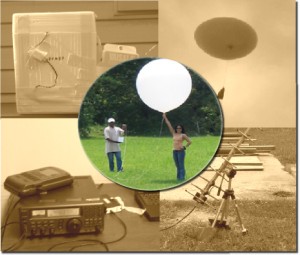 Beginning in 2005, the Department of the Environment in partnership with
Howard University's Climate and Radiation Group have sponsored ozonesonde measurements at the Howard University Beltsville Campus located in Beltsville, MD. This project is designed to provide additional information about ozone pollution transport into Maryland via the Nocturnal Low Level Jet (NLLJ), and its effects on Maryland's air quality.
Beginning in 2005, the Department of the Environment in partnership with
Howard University's Climate and Radiation Group have sponsored ozonesonde measurements at the Howard University Beltsville Campus located in Beltsville, MD. This project is designed to provide additional information about ozone pollution transport into Maryland via the Nocturnal Low Level Jet (NLLJ), and its effects on Maryland's air quality.
Ozonesondes are a collection of instruments contained in a small styrofoam container, which measures ozone, temperature, relative humidity, pressure, and wind speed and direction from the surface to a height of 10 kilometers (6.2 miles) or higher. Ozonesondes are launched during June, July, and August when high ozone pollution episodes are predicted by the Department's forecast team. Ozonesonde launches are typically scheduled for the pre-dawn, mid-late afternoon, and early evening hours. Ozonesonde packages are labeled with a description of the contents, contact name, and phone number to help eliminate concerns should the packages be discovered by the public.
Ozonesondes are tied to a 50-foot string and suspended beneath a free flying weather balloon. Data are collected instantaneously and transmitted back to the Howard University scientists on the ground as the weather balloon ascends into the sky. Measurements collected can be used to create vertical profiles of ozone, temperature, and relative humidity to help determine the magnitude of ozone being transported into Maryland.
Ozonesondes have been successful at measuring the ozone pollution being transported into Maryland from upwind areas during the late night/early morning hours via the NLLJ. The NLLJ is a fast-moving stream of air that flows from the south/southwest to north/northeast. It forms between the Appalachian Mountains and the Atlantic Ocean during the late night and early morning hours under certain meteorological conditions and is responsible for transporting ozone and ozone precusors into Maryland at the altitudes of between roughly 100 meters to about a few hundreds meters above the surface. Ozonesondes have measured ozone concentrations of approximately 100 ppb at 3 a.m at a height of approximately 500 meters (1,640 feet). For reference, an exceedance of the national 8-hour ozone standard occurs when ozone levels exceed 75 ppb.